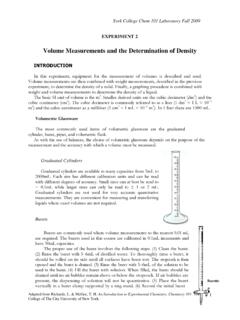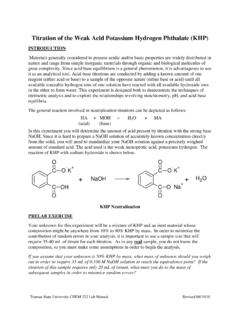Transcription of Weighing Measurements: The Balance
1 EXPERIMENT 1 Weighing Measurements: The Balance INTRODUCTIONC hemistry is an experimental science.
2 This means that chemical knowledge must be based on and supported by data collected during carefully controlled chemical experiments. Typical of the data collected in the chemistry laboratory are measurements of such quantities as length, mass, volume , temperature, and time, and observations of physicalpropertiessuchas color and stateof matter. The accurate determination and expression of these fundamental quantities must be mastered if one is to obtain and report meaningful, reliable, and reproducible results. In the first experiment, two instruments for measuring mass are described and used; they are the beam Balance and the analytical Balance .
3 The second experiment involves the accurate measurement of volume . The third and fourth experiments involveobservationofpropertiesofsolution sand ofchangesthatoccurin chemicalreactions. Weight and Mass Beforeconsideringtheinstruments,thedisti nctionbetweentheweightandmassofanobjects hould substance and has a constant value no matter where it is measured. Weight is not a fundamental property of matter. It is a measure of the gravitational attraction on the object and is related to the massbytheequation w = mg whereg ,atsealevel, g is equal /sect. Sinceg isnot constant, theweightofan objectdependsonitslocation.
4 In chemical experiments mass is always measured, since data should not depend on bycomparing an objectofunknownmass withknown masses. Sincetheaccelerationduetogravityis exerted equally onall massesatagivenlocation,themassof theunknown objectcanbeobtained. Unfortunately, in common practice, chemists do not rigorously maintain the distinction between the terms weight and mass. The use of the Balance is termed " Weighing ," the objects of knownmassarecalled"weights"andthemassoft heunknownobjectiscalledits"weight." The basic SI unit of mass is the kilogram. Other common units related to the kilogram are listed below.
5 Un itsof Mass 1 kilogram (kg) = 1,000 grams (g) 1 milligram (mg) = 10 3 g = ( g)=10 6 g Adapted from Richards, L. & McGee, T. H. An Introduction to Experimental Chemistry: Chemistry 101. York College of The City University of New York. 1 Beam Balances The triple beam Balance can measure mass to the nearest tenth of a gram ( g).
6 The quadruple beam Balance can measure mass to the nearest one hundredth of a gram ( g). Both balances are useful for measuring large quantities of material or when only approximate amounts of material are required. They are fairly rugged and easy to use. The object to be measured is placed on the pan and the weights are systematically adjusted on the beams until Balance is achieved. For example, the three arms of the triple beam Balance are calibrated from 0 100, 0 10, and 0 grams. First the weight on the 0 100 arm is moved along the beam in 10 gram increments until the increment of weight exceeds the object weight by one unit.
7 The weight is then returned to the next lower value. This procedure is repeated with the weights on the 0 10 gram arm and the 0 gram arm until the Balance point is reached. An object Weighing would have the weight on the 0 100 g arm set at 30, the weight on the 0 10 g arm set at 4, and the weight on the 0 g arm set at when at Balance . Figure 1-1. Photograph of an Ohaus Model 3600 Beam Balance . Courtesy of Ohaus Scale Corporation. Analytical Balances The analytical Balance can measure mass to the nearest tenth of a milligram ( mg or g). It is a more sensitive instrument than the beam Balance , and is used for measuring small quantities of material or when very accurate weighings are required.
8 Adapted from Richards, L. & McGee, T. H. An Introduction to Experimental Chemistry: Chemistry 101. York College of The City University of New York. 2
9 Uncertainty in Measurements When a measurement is made on an instrument there always exists some uncertainty or error in that measurement . Uncertainties or errors in a measurement are of two types: systematic errors and random errors. Systematic errors are those inherent in the instrument or the method used to make the measurement . They affect all results in the same direction to the same extent.
10 For example, a systematic error would result from incorrect degree markings on a thermometer that caused all temperature readings to be low. This type of error can often be evaluated and suitable corrections can be made to the data. Random errors occur mainly because of the limitations of the instrument and of the observer in making the measurement . Estimates of correct values are always made in recording measurements from dials, meters, or calibrated glassware. These estimates occur in the last decimal place that the instrument can measure and are always subject to the judgment of the observer.



